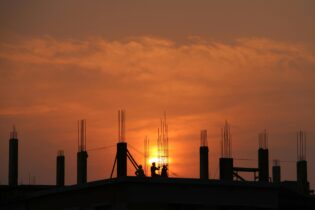A joint initiative between Old Mutual and FirstRand Bank, the R1.6 billion Portside building is set to not only become a landmark tower in the emerging financial district in the Foreshore area of Cape Town’s central business district, but it also aims for a four-Green Star SA Office rating from the Green Building Council of South Africa (GBCSA). If achieved, this rating will make it one of the most sustainable buildings in South Africa and puts it on par with the head office of Alexander Forbes in Sandton, Johannesburg, which has already achieved this rating.
The building will feature 32 floors, over 52 000 square metres of office space and 1 200 of retail and banking space. It will host 1 382 parking bays. In order to successfully construct an efficient, sustainable green building, a well-integrated design approach has been adopted. Throughout the design stages and during construction, the incorporation of green building principles will be monitored and evaluated to ensure the successful achievement of the rating – which will ultimately showcase innovative green design in South Africa, create an exceptionally healthy working environment and practically demonstrate sustainable design for Cape Town. The Green Star SA rating system from the GBCSA incorporates measurable environmental initiatives included in the base building design and construction. These initiatives, or credits, pertain to eight categories which include management, indoor environmental quality, energy, transport, water, materials, land use and ecology, and emissions. An environmental management plan (EMP) covering all construction activities has been devised for the project, as well as a waste management plan (WMP), prepared by the contractor, ensuring that 70% of all construction waste is either reused or recycled. The building will be provided with 150% more fresh air than stipulated in normal standards and view-optimising vision glazing is a feature of the building and will provide natural day lighting. The lighting system will be energy efficient, incorporating light and movement sensors. Provision will be made for approximately 260 bicycles – together with secure racks, showers and lockers. Grey water will be captured and filtered from showers and hand basins and, along with captured rainwater, will be used in the toilets. The façade is designed to be disassembled and re-erected on another site should the Portside be altered in the future for any reason. Due to efficient green-energy innovations, tenants can expect to pay 30% less for electricity.Green buildings have been shown to have many benefits to both tenant and landlord, and include:
Improved Individual Productivity (performance of specific tasks): given the fact that staff remuneration is one of the greatest operational costs of any company, this is significant. It improves productivity of the organisation as a whole. Increased Human Health: research has shown that there are numerous benefits including a reduction in respiratory and eye related complaints, fewer mucosal symptoms and a marked reduction in absenteeism. Cost Savings: a reduction in predominately energy and water use results in considerable operational cost savings for both landlord and tenants which leads to reduced operational requirements from, for example, heating, cooling, ventilation and lighting costs, both capital and operational, For instance: passive solar can displace 20 to40% of today’s heating; shade can displace 20 to 40% of today’s cooling; natural ventilation can displace 80% of today’s ventilation and daylight can displace 35 to 75% of today’s lighting Green building is slowly gaining momentum in South Africa. For more information, please log on to www.gbcsa.org.za







